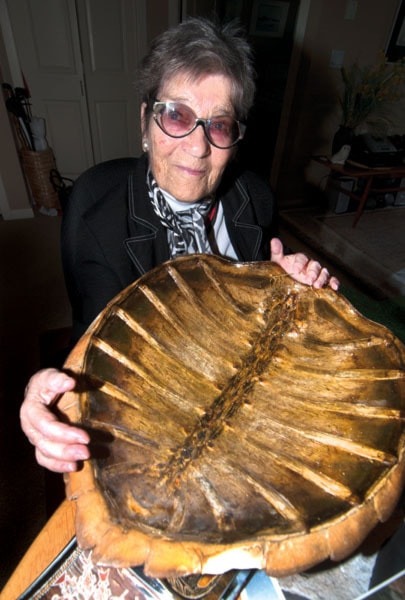Tatjana Schmidt-Derstroff’s exotic travels are over, but the explorer/scientist/photographer/artist has many adventures stored safely away in her extraordinary memory bank.
Schmidt-Derstroff has explored places, many of which remain well off the beaten track, made significant scientific contributions, created awe-inspiring art from her photographs and collected artifacts and mementos along the way.
Born in Berlin, Germany, she entered university to study medicine and journalism – pursuits that were interrupted by the Second World War.
Now 92, Schmidt-Derstroff married and raised four children before pursuing a passion for anthropology and archaeology that had simmered in her soul since she viewed rock engravings at the age of eight.
It is a passion that vibrates palpably when this remarkable woman spins her tales of travelling the world on her own, “following Aborigines wherever they might have left their trails.”
Schmidt-Derstroff viewed many cave paintings in France, including the world-famous Lascaux Cave, which is no longer open to the public. She also visited the Altamira cave in Spain, considered to be the Sistine Chapel of the Stone Age.
“I saw many wonderful engravings, paintings and chiffres (symbols) on rock walls in North and East Africa,” she says. “I also visited many similar sites in India, Malaysia, Indonesia and New Zealand.”
But it was Australia, the land she first visited in 1972, that captured her mind and heart, and drew her back over a period of 27 years.
Schmidt-Derstroff flew to many otherwise inaccessible areas with a flying bishop as he made parish calls in his vast Australian diocese.
The photographs she took from his small aircraft, through often-dirty windows and with a simple camera, provided her with spectacular “Earth art.”
“These timeless landscapes afford form and colour without need of dramatics, without fantasy,” she says in her artist’s statement. “There is no illusory alienation, just nature as a wonderful designer in watercolours, sculpture and graphic design.”
Dressed in long, cotton pants to prevent mosquito and snake bites, her hair cut short and her bosom under wraps, Schmidt-Derstroff further camouflaged her womanhood by carrying a rifle, machete, bush knife and camera when she ventured into remote areas.
“In areas inaccessible, remote and often untouched by explorers, I viewed and photographed the prehistoric galleries of engravings and petroglyphs of early man,” she says. “These ancient images are archives on stone and act as textbooks or diaries of tribal events, and tell of their cultural history and creation myths.”
Some of the stories were explained by Aborigines using sticks to make pictures in the sand.
Schmidt-Derstroff carried out her Australia fieldwork for four to seven months a year, publishing her findings in scientific papers and popular German magazines.
Over the years, she documented her work in 38,000 slides and shared her experiences and expertise at many German universities, and made radio and television appearances, including a weekly hourlong educational radio broadcast in Australia.
In 1992, Schmidt-Derstroff and her husband emigrated to Salmon Arm, where she continues to reside.
Now a widow and survived by only one of her children, Schmidt-Derstroff has endeavoured to make sure her priceless collections are well cared for and accessible to many. She has chosen to keep them in Canada, a country she says has been good to her.
Schmidt-Derstroff made her first big contribution, a collection of Australian artifacts to the University of Saskatchewan’s archaeology department.
Her second donation was an earth art collection that hangs in Vernon Jubilee Hospital. Next came the sale of her paintings in a silent auction, with proceeds going to the Canadian Cancer Society.
Most recently, Schmidt-Derstroff has given “Architects Under Water,” to the Salmon Arm campus of Okanagan College. She calls this collection a “side effect” of her real work, because she took the photos in Indonesia or Fiji, places she went to relax and snorkel or dive after long stints of scientific fact-finding in Australia.
Through her curiosity, passion and dedication, Schmidt-Derstroff collected knowledge and artifacts that continue to excite and educate.
